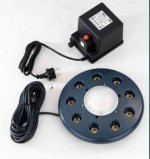Crucial said:
SwiM was wondering first off if SwiY was using a thimble or cotton at the bottom of extractor..... there might be something to be said for investing a couple dollars in a good thimble
Unfortunately a thimble would not fit into swim's extractor. It is not a soxhlet.
Crucial said:
although I think surface tension is allowing your powdered mass to clog your soxhlet.
That's right, because there is no clogging at all with IPA.
Crucial said:
It seems (maybe) there might be a period of time where the powdered mass becomes fully saturated resulting in the eventual even flow of the extraction fluid.
SO.... have you tried to 'presoak' your powder in the same solution you anticipate doing your extraction with?
Cover you powdered mass with just enough fluid to create a slurry and allow it to sit for a few hours (or just pre-prepare this the day before) allowing the fibers to soak up all the fluids they can hold (well past field capacity) and then place your "paste" in the thimble (or extractor with cotton, also pre-saturated) and initiate soxhlet extraction the same as you would normally.
Just a thought...
Hmmmm... Not sure. Swim conducted a number of experiments. She loaded her extractor with:
1. Dry mhrb
2. Freshly soaked mhrb
3. Presoaked mhrb (~1 day)
4. Presoaked, freeze/thawed mhrb
5. Presoaked, freeze/thawed in a microwave oven.
She also experimented with different leavening agents (coarse sand, diatomceous earth, perlite, vermiculite).
Dry loaded mhrb was the worst. It caked stone-hard after coming into contact with water.
Freshly soaked mhrb was better but clogging still was severe.
Perlite proved to be the best anti-clogging addive because it is less dense than water. During extraction it gradually floats up and water goes down. Once the extractor clogged completely it is only necessary to remove the cotton ball, drain the water, plug another cotton ball and pour the water on top of perlite. The process has to be repeated 2-3 more times and then there is no more clogging.
Sand is not good because it is heavier than water and moves to the bottom. Once the extractor is clogged it has to be cleared completely. Various combinations of the above substances were also tested. Clogging would not go.
Next time Swim plans to try some ideas suggested by 69ron
69ron said:
Here’s the trick that pro’s use to prevent the filters from clogging. Add 1 cm of diatomaceous earth on top of the filter in the Buchner funnel, and then put another filter on top of the diatomaceous earth. The filter on top of the diatomaceous earth prevents the diatomaceous earth from moving around while you pour your extract over it. With this method, swim has never had a filter ever get clogged.
For all these experiments swim used 90 g of mhrb. After filtering and reduction she ended up with 300 ml of clear dark purple liquid (pH ~12.6). She defatted it once with heptane and proceeded to basify it. Then something strange happened. The liquid went white then, with more lye added to the solution, its color became latte and stayed that regardless of how much more lye was added. Usually with similar amounts it was required to add 5-10 g of lye for the liquid to turn almost completely black. This time she added ~35 g and the color did not change much. Moreover, when swim tried to pull with heptane thick emulsion appeared. It would not go for 12 hours.
Only after diluting the basified liquid from 300 ml to 800 ml swim was able to finish the NP pulls.
Combined pulls were reduced from 200 ml to 30 ml and are sitting in a fridge now.

